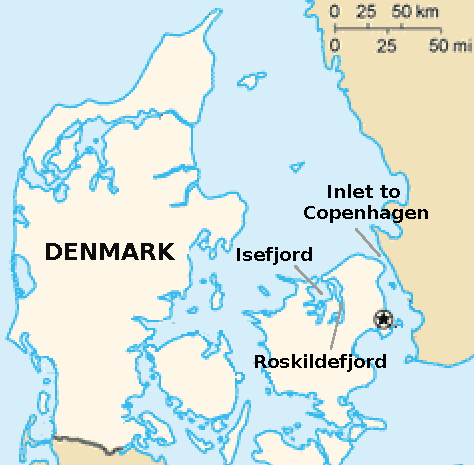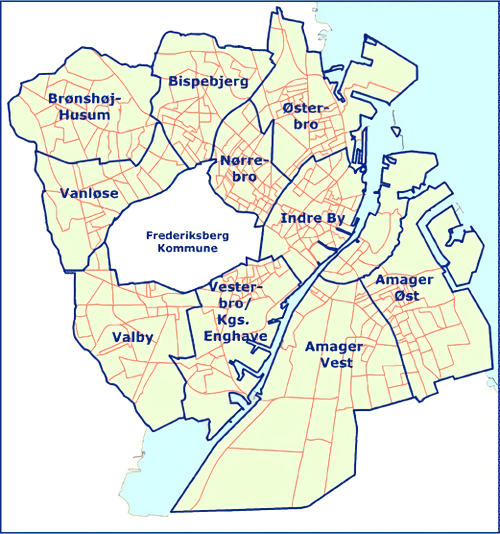|
Prøvestenen, Copenhagen
Prøvestenen, also known as Benzinøen, is an artificial island off the northeast coast of Amager in Copenhagen, Denmark. It is located between the Amager Hill combined incineration plant and ski slope to the north and Amager Strandpark to the south. It was created as a marine fortress to guard the entrance to Copenhagen Harbour in the second half of the 18th century and served military purposes until 1922. It now houses the city's petroleum harbor. Prøvestensbroen at the end of Prags Boulevard links it with the rest of Amager. History The area traces its history back to 1713 when a marine battery was established at the site by wrecking the floating dock Prøvestenen. The work was led by Ole Judichær. Another marine fortress, Trekroner Fort, was also built at this point. The battery fell into neglect over the following years. In 1723-24 three more ships were wrecked at the site to expand it but it was once again severely damaged by storms and ice and in 1736. In 1736, it was ... [...More Info...] [...Related Items...] OR: [Wikipedia] [Google] [Baidu] |
Trekroner Fort
Trekroner Søfort (literally ''Three Crowns Sea Fortress'') is a Coastal defence and fortification#Sea forts, sea fort at the entrance to the Copenhagen#Harbour, Copenhagen harbour. From 1713 until after World War I, Trekroner Fort was part of the fortifications of Copenhagen. The original location of Trekroner Fort was a few hundred meters north of the current one. In 1713, three old ships of the line were sunk to form the basis for a battery. One of the ships was called ''Trekroner'', and she gave her name to the fort. Construction of the current fort began in 1787. The fort was an important part of the Danish line of defense during the Battle of Copenhagen (1801), Battle of Copenhagen in 1801. The fort also was engaged during the Battle of Copenhagen (1807), British attack on Copenhagen in 1807. From 1818 to 1828 and in 1860, the fort was strongly enhanced, but its military significance diminished after the First World War. In 1934 it was sold to the Copenhagen harbour servi ... [...More Info...] [...Related Items...] OR: [Wikipedia] [Google] [Baidu] |
Fortifications Of Copenhagen
The fortifications of Copenhagen is the broad name for the rings of fortifications surrounding the city of Copenhagen. They can be classified historically as follows: * The medieval fortifications dating from the 12th century * The bastioned fortifications dating from the 17th century * The ring fortification system dating from the 19th century Medieval fortifications (12th–15th centuries) The first fortification was the castle built by bishop Absalon in 1167 on Slotsholmen at the foundation of the city. This stood for 200 years until it was destroyed by the Hanse in 1369. It was replaced in 1417 by the Copenhagen Castle built by the then bishop, but taken over by the king, Eric of Pomerania. The ruins of both these castles are visible to the public view under the Christiansborg Palace. Bastioned Fortifications (17th century) The city was extensively fortified by Christian IV in the mid 17th century. To the west the city was protected by a series of ramparts and bastions nort ... [...More Info...] [...Related Items...] OR: [Wikipedia] [Google] [Baidu] |
Ferdinand Meldahl
Ferdinand Meldahl (16 March 1827 – 3 February 1908) was a Danish architect best known for the reconstruction of Frederiksborg Castle after the fire in 1859. Meldahl was one of the leading proponents of historicism in Denmark. Biography He was the son of architect Heinrich Meldahl. He worked in his father's iron foundry and was also trained as a bricklayer. He joined the Royal Danish Academy of Fine Arts, where he was educated as an architect. He conducted several study trips to Germany, France, Spain, the Netherlands, England, Egypt and Syria. As a member of the municipal council of Copenhagen Municipality for 27 years from 1866, Meldahl managed to significantly influence the city. In 1857, he became a member of the Royal Danish Academy of Fine Arts and in 1863 a professor at the academy. He was its manager from 1873 to 1890. In 1904, he was appointed a Knight Grand Cross of the Royal Victorian Order on the occasion of the visit of King Edward VII of the United Kingdom. At ... [...More Info...] [...Related Items...] OR: [Wikipedia] [Google] [Baidu] |
English Wars (Scandinavia)
The English Wars ( da, Englandskrigene, sv, Englandskrigen) were a series of conflicts pitting the United Kingdom and Sweden against Denmark-Norway as part of the Napoleonic Wars. It is named after England, the common name in Scandinavia for the United Kingdom, which declared war on Denmark-Norway due to disagreements over the neutrality of Danish trade and to prevent the Danish fleet falling into the hands of the First French Empire. It began with the first battle of Copenhagen in 1801 and its latter stage from 1807 onwards was followed by the Gunboat War, the Dano-Swedish War of 1808–09 and the Swedish invasion of Holstein in 1814. Prelude After the death of Denmark-Norway's foreign minister Andreas Peter Bernstorff in 1800, crown prince Frederick began exerting his will in all areas. This meant that the finance minister Ernst Heinrich von Schimmelmann ignored protests from the foreign minister Christian Bernstoff to finally grant the Dutch-born merchant Frédéric d ... [...More Info...] [...Related Items...] OR: [Wikipedia] [Google] [Baidu] |
Carl Neumann - Prøvestenen Ca 1863
Carl may refer to: * Carl, Georgia, city in USA * Carl, West Virginia, an unincorporated community *Carl (name), includes info about the name, variations of the name, and a list of people with the name * Carl², a TV series * "Carl", an episode of television series ''Aqua Teen Hunger Force'' * An informal nickname for a student or alum of Carleton College CARL may refer to: * Canadian Association of Research Libraries * Colorado Alliance of Research Libraries See also *Carle (other) *Charles *Carle, a surname * Karl (other) *Karle (other) Karle may refer to: Places * Karle (Svitavy District), a municipality and village in the Czech Republic * Karli, India, a town in Maharashtra, India ** Karla Caves, a complex of Buddhist cave shrines * Karle, Belgaum, a settlement in Belgaum d ... {{disambig ja:カール zh:卡尔 ... [...More Info...] [...Related Items...] OR: [Wikipedia] [Google] [Baidu] |
Battle Of Copenhagen (1801)
The Battle of Copenhagen of 1801 (Danish: ''Slaget på Reden''), also known as the First Battle of Copenhagen to distinguish it from the Second Battle of Copenhagen in 1807, was a naval battle in which a British fleet fought and defeated a smaller force of the Dano-Norwegian Navy anchored near Copenhagen on 2 April 1801. The battle came about over British fears that the powerful Danish fleet would ally with France, and a breakdown in diplomatic communications on both sides. As the British ships entered the harbour of the Danish fleet, several of its ships stationed in the city's inlet forming a blockade. The Danish fleet defended the capital with these ships and bastions on both sides of the harbour inlet. It was the second attempt by the British to try to prevent a Franco-Danish alliance, as the British had already entered Øresund with a fleet in August 1800, in order to persuade Denmark not to ally with France. The Danes agreed to the British terms upon hearing news of the ... [...More Info...] [...Related Items...] OR: [Wikipedia] [Google] [Baidu] |
Ole Judichær
Ole (Olaus) Judichær (20 March 1661 29 September 1729) was a Danish shipbuilder and admiral in the Royal Danish Navy. Early life Ole (or Olaus) Judichær was born on 20 March 1661 in Gotland,Bjerg in Gyldendal although this date may have been 20 February 1661Project RuneberVol 8 pp 554 - 556/ref> where his father was the parish priest in the very south of the island. At the age of seventeen he departed for Copenhagen where, in 1683 and 1684, he studied theology. Later he studied mathematics under the scientist Ole Rømer, who recommended Judichær to Niels Juel and to Admiral Henrik Span. He became tutor to the household of the latter, during which time he occasionally preached in the naval Church of Holmen. Naval career In 1690 he was appointed deputy dockmaster at Bremerholm (better known as Gammelholm in today’s Copenhagen) and a short time thereafter as leader in the shipbuilding department. With the launch of the ship-of-the-linDannebrogein 1692 – the first ship to be ... [...More Info...] [...Related Items...] OR: [Wikipedia] [Google] [Baidu] |
Amager
Amager ( or, especially among older speakers, ) in the Øresund is Denmark's most densely populated island, with more than 212,000 inhabitants (January 2021) a small appendage to Zealand. The protected natural area of ''Naturpark Amager'' (including Kalvebod Fælled) makes up more than one-third of the island's total area of 96 km2. The Danish capital, Copenhagen Municipality, is partly situated on Amager, covering the northern part of the island, which is connected to the much larger island of Zealand by eight bridges and a metro tunnel. Amager also has a connection across the Øresund to Sweden, the Øresund Bridge. Its western part begins with a tunnel from Amager to another Danish island, Peberholm. Copenhagen Airport is located on the island, around from Copenhagen city centre. Amager is the largest island in the Øresund, and the only one with a large population. , 212,661 people lived on the island, including its northern tip, Christianshavn. The northern part is in ... [...More Info...] [...Related Items...] OR: [Wikipedia] [Google] [Baidu] |
Prøvestenen (Slaget På Reden (now in Ghana)
{{disambiguation ...
Prøvestenen may refer to: * Prøvestenen, Copenhagen * Prøvestenen, Helsingør ** Prøvestenscentret * Fort Prøvestenen, an auxiliary fort near the Danish colonial Fort Christiansborg Osu Castle (also known as Fort Christiansborg or the Castle) is a castle located in Osu, Ghana on the coast of the Gulf of Guinea in Africa. A substantial fort was built by Denmark-Norway in the 1660s, thereafter the fort changed ownership ... [...More Info...] [...Related Items...] OR: [Wikipedia] [Google] [Baidu] |





